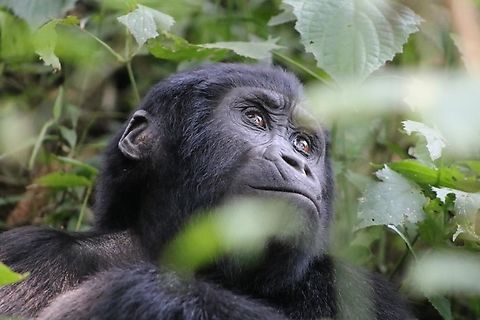
Appearance
The fur of the mountain gorilla, often thicker and longer than that of other gorilla species, enables them to live in colder temperatures. Gorillas can be identified by nose prints unique to each individual. Males, at a mean weight of 195 kg and upright standing height of 150 cm usually weigh twice as much as the females, at a mean of 100 kg and a height of 130 cm. This subspecies is on average the second largest species of primate; only the Eastern Lowland Gorilla, the other subspecies of Eastern Gorilla, is larger. Adult males have more pronounced bony crests on the top and back of their skulls, giving their heads a more conical shape. These crests anchor the powerful temporalis muscles, which attach to the lower jaw. Adult females also have these crests, but they are less pronounced. Like all gorillas they feature dark brown eyes framed by a black ring around the iris.Adult males are called silverbacks because a saddle of gray or silver-colored hair develops on their backs with age. The hair on their backs is shorter than on most other body parts, and their arm hair is especially long. Fully erect, males reach 1.9 m in height, with an arm span of 2.3 m and weigh 220 kg. The tallest silverback recorded was a 1.94 m individual shot in Alimbongo, northern Kivu in May 1938. There's an unconfirmed record of another individual, shot in 1932, that was 2.06 m tall. The heaviest was a 1.83 m silverback shot in Ambam, Cameroon which weighed about 266 kg.
The mountain gorilla is primarily terrestrial and quadrupedal. However, it will climb into fruiting trees if the branches can carry its weight, and it is capable of running bipedally up to 6 m. Like all great apes other than humans, its arms are longer than its legs. It moves by knuckle-walking, supporting its weight on the backs of its curved fingers rather than its palms.
The mountain gorilla is diurnal, most active between 6:00 a.m. and 6:00 p.m. Many of these hours are spent eating, as large quantities of food are needed to sustain its massive bulk. It forages in early morning, rests during the late morning and around midday, and in the afternoon it forages again before resting at night. Each gorilla builds a nest from surrounding vegetation to sleep in, constructing a new one every evening. Only infants sleep in the same nest as their mothers. They leave their sleeping sites when the sun rises at around 6 am, except when it is cold and overcast; then they often stay longer in their nests.
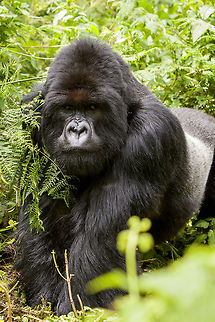
Distribution
Conservation efforts have led to an increase in overall population of the mountain gorilla in the Virungas and at Bwindi. The overall population is now believed to be at least 880 individuals. Three more – infants who suffered a traumatic poaching experience, injuries from snares, and/or losing their mothers in brutal killings – are currently in care of the Senkwekwe Centre orphanage in the DR of Congo.In December 2010 the official website of Virunga National Park announced that "the number of mountain gorillas living in the tri-national forested area of which Virunga forms a part, has increased by 26.3% over the last seven years - an average growth rate of 3.7% per annum." The 2010 census estimated that 480 mountain gorillas inhabited the region. The 2003 census had estimated the Virunga gorilla population to be 380 individuals; which represented a 17% increase in the total population since 1989 when there were 320 individuals The population has almost doubled since its nadir in 1981, when a census estimated that only 254 gorillas remained.
The 2006 census at Bwindi indicated a population of 340 gorillas, representing a 6% increase in total population size since 2002 and a 12% increase from 320 individuals in 1997. All of those estimates were based on traditional census methods using dung samples collected at night nests. Conversely, genetic analyses of the entire population during the 2006 census indicated there were only approximately 300 individuals in Bwindi. The discrepancy highlights the difficulty in using imprecise census data to estimate population growth.
In both Bwindi and the Virungas, groups of gorillas that were habituated for research and ecotourism have higher growth rates than unhabituated gorillas, according to computer modeling of their population dynamics. Habituation means that through repeated, neutral contact with humans, gorillas exhibit normal behavior when people are in close proximity. Habituated gorillas are more closely guarded by field staff and they receive veterinary treatment for snares, respiratory disease, and other life-threatening conditions. Nonetheless, researchers recommended that some gorillas remain unhabituated as a bet-hedging strategy against the risk of human pathogens being transmitted throughout the population.
Despite their recent population growth, the mountain gorilla remains threatened. Mountain gorillas are listed as Critically Endangered on the IUCN Red List and are dependent on conservation efforts to survive.
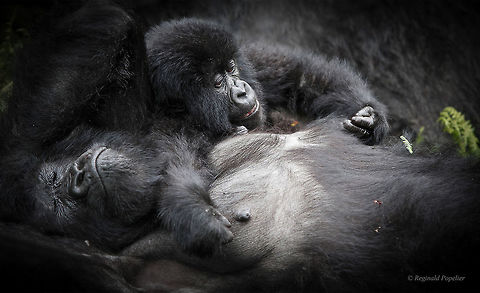
Status
The main International Non-Government Organization involved in conservation of mountain gorillas is the International Gorilla Conservation Programme, which was established in 1991 as a joint effort of the African Wildlife Foundation, Fauna & Flora International and the World Wide Fund for Nature. Conservation requires work at many levels, from local to international, and involves protection and law enforcement as well as research and education. Dian Fossey broke down conservation efforts into the following three categories:Active conservation includes frequent patrols in wildlife areas to destroy poacher equipment and weapons, firm and prompt law enforcement, census counts in regions of breeding and ranging concentration, and strong safeguards for the limited habitat the animals occupy."
Theoretical conservation seeks to encourage growth in tourism by improving existing roads that circle the mountains, by renovating the park headquarters and tourists' lodging, and by the habituation of gorillas near the park boundaries for tourists to visit and photograph."
Community-based conservation management involves biodiversity protection by, for, and with the local community in practise this is applied in varying degrees. The process seeks equity between meeting the needs of the local population and preserving the protected areas and involves local people in decision making processes.
A collaborative management process has had some success in the Bwindi National Park. The forest was gazetted to National Park in 1991; this occurred with little community consultation and the new status prohibited local people from accessing resources within the park as well as reduced economic opportunities. Subsequently a number of forest fires were deliberately lit and threats were made to the gorillas. To counteract this, three schemes to provide benefits from existence of the forest communities and involve the local community in park management were developed. They included agreements allowing the controlled harvesting of resources in the park, receipt of some revenue from tourism and establishment of a trust fund partly for community development. Tension between people and park have been reduced and now there is more willingness to take part in gorilla protection. Surveys of community attitudes conducted by CARE show a steadily increasing proportion of the people in favour of the park. More than that there have been no cases of deliberate burning and the problem of snares in these areas has been reduced.
The introduction of ceremonies such as Kwita Izina has also had some impact in drawing attention to gorilla preservation and its importance to local communities.
While community-based conservation bears out individual analysis, there are significant overlaps between active and theoretical conservation and a discussion of the two as halves of a whole seems more constructive. For example, in 2002 Rwanda's national parks went through a restructuring process. The director of the IGCP, Eugene Rutagarama stated that “They got more rangers on better salaries, more radios, more patrol cars and better training in wildlife conservation. They also built more shelters in the park, from which rangers could protect the gorillas". The funding for these types of improvements usually comes from tourism - in 2008, approximately 20 000 tourists visited gorilla populations in Rwanda, generating around $8 million in revenue for the parks. In Uganda too, tourism is seen as a “high value activity that generates enough revenue to cover park management costs and contribute to the national budget of the Uganda Wildlife Authority." Furthermore, tourist visits which are conducted by park rangers also allow censuses of gorilla sub-populations to be undertaken concurrently.
In addition to tourism, other measures for conservation of the sub-population can be taken such as ensuring connecting corridors between isolated areas to make movement between them easier and safer.
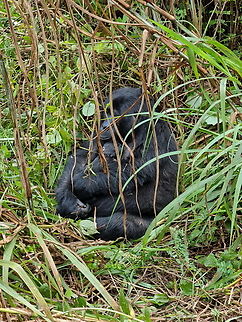
Behavior
The mountain gorilla is highly social, and lives in relatively stable, cohesive groups held together by long-term bonds between adult males and females. Relationships among females are relatively weak. These groups are nonterritorial; the silverback generally defends his group rather than his territory. In the Virunga mountain gorillas, the average length of tenure for a dominant silverback is 4.7 years.61% of groups are composed of one adult male and a number of females and 36% contain more than one adult male. The remaining gorillas are either lone males or exclusively male groups, usually made up of one mature male and a few younger males. Group sizes vary from five to thirty, with an average of ten individuals. A typical group contains: one dominant silverback, who is the group's undisputed leader; another subordinate silverback; one or two blackbacks, who act as sentries; three to four sexually mature females, who are ordinarily bonded to the dominant silverback for life; and from three to six juveniles and infants.
Most males, and about 60% of females, leave their natal group. Males leave when they are about 11 years old, and often the separation process is slow: they spend more and more time on the edge of the group until they leave altogether. They may travel alone or with an all-male group for 2–5 years before they can attract females to join them and form a new group. Females typically emigrate when they are about 8 years old, either transferring directly to an established group or beginning a new one with a lone male. Females often transfer to a new group several times before they settle down with a certain silverback male.
The dominant silverback generally determines the movements of the group, leading it to appropriate feeding sites throughout the year. He also mediates conflicts within the group and protects it from external threats. When the group is attacked by humans, leopards, or other gorillas, the silverback will protect them even at the cost of his own life. He is the center of attention during rest sessions, and young animals frequently stay close to him and include him in their games. If a mother dies or leaves the group, the silverback is usually the one who looks after her abandoned offspring, even allowing them to sleep in his nest. This is a form of alloparental care which is a common behavior and is seen in many other animal species such as the elephant and the wolf. Experienced silverbacks are capable of removing poachers' snares from the hands or feet of their group members.
When the dominant silverback dies or is killed by disease, accident, or poachers, the family group may be severely disrupted. Unless he leaves behind a male descendant capable of taking over his position, the group will either split up or be taken over in its entirety by an unrelated male. When a new silverback takes control of a family group, he may kill all of the infants of the dead silverback. This practice of infanticide is an effective reproductive strategy, in that the newly acquired females are then able to conceive the new male's offspring. Infanticide has not been observed in stable groups.
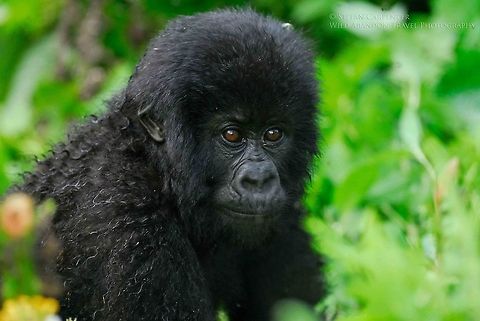
Habitat
The mountain gorilla inhabits the Albertine Rift montane cloud forests and of the Virunga Volcanoes, ranging in altitude from 2,200–4,300 metres. Most are found on the slopes of three of the dormant volcanoes: Karisimbi, Mikeno, and Visoke. The vegetation is very dense at the bottom of the mountains, becoming more sparse at higher elevations, and the forests where the mountain gorilla lives are often cloudy, misty and cold.The mountain gorilla is primarily a herbivore; the majority of its diet is composed of the leaves, shoots and stems of 142 plant species. It also feeds on bark, roots, flowers, and fruit, as well as small invertebrates.. Adult males can eat up to 34 kilograms of vegetation a day, while a female can eat as much as 18 kilograms.
The home range size is influenced by availability of food sources and usually includes several vegetation zones. George Schaller identified ten distinct zones, including: the bamboo forests at 2,200–2,800 metres; the "Hagenia" forests at 2,800–3,400 metres; and the giant senecio zone at 3,400–4,300 metres. The mountain gorilla spends most of its time in the Hagenia forests, where galium vines are found year-round. All parts of this vine are consumed: leaves, stems, flowers, and berries. It travels to the bamboo forests during the few months of the year fresh shoots are available, and it climbs into subalpine regions to eat the soft centers of giant senecio trees.
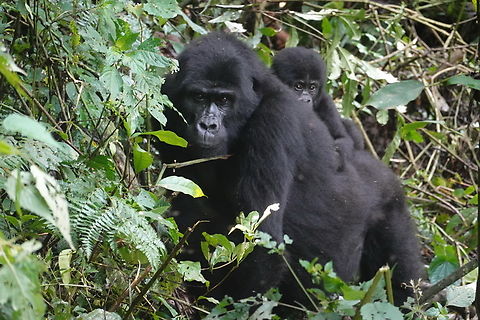
Predators
As with any flora and fauna, the decline of a population can usually be attributed to anthropogenic factors. Pollution, habitat destruction and fragmentation, over-harvesting, agriculture, and the introduction of diseases are some of the usual suspects; the mountain gorilla suffers from all of these. All of the aforementioned are due to the most significant threat to gorilla survival: human population growth.Poaching: Mountain gorillas are not usually hunted for bushmeat, but they are frequently maimed or killed by traps and snares intended for other animals. They have been killed for their heads, hands, and feet, which are sold to collectors. Infants are sold to zoos, researchers, and people who want them as pets. The abduction of infants generally involves the loss of at least one adult, as members of a group will fight to the death to protect their young. The Virunga gorillas are particularly susceptible to animal trafficking for the illegal pet trade. With young gorillas worth from $1000 to $5000 on the black market, poachers seeking infant and juvenile specimens will kill and wound other members of the group in the process. Those of the group that survive often disband. One well documented case was that known as the ‘Taiping 4’. In this situation, a Malaysian Zoo received four wild-born infant gorillas from Nigeria at a cost of US$1.6 million using falsified export documents.
Poaching for meat is also particularly threatening in regions of political unrest. Most of the African great apes survive in areas of chronic insecurity, where there is a breakdown of law and order. The killing of mountain gorillas at Bikenge in Virunga National Park in January 2007 was a well documented case.
Habitat loss: This is one of the most severe threats to gorilla populations. The forests where mountain gorillas live are surrounded by rapidly increasing human settlement. Through shifting agriculture, pastoral expansion and logging, villages in forest zones cause fragmentation and degradation of habitat. The late 1960s saw the Virunga Conservation Area of Rwanda’s national park reduced by more than half of its original size to support the cultivation of Pyrethrum. This led to a massive reduction in mountain gorilla population numbers by the mid-1970s. The resulting deforestation confines the gorillas to isolated deserts. Some groups may raid crops for food, creating further animosity and retaliation.
The impact of habitat loss extends beyond the reduction of suitable living space for gorillas. As gorilla groups are increasingly geographically isolated from one another due to human settlements, the genetic diversity of each group is reduced. Some signs of inbreeding are already appearing in younger gorillas, including webbed hands and feet.
Disease: Despite the protection garnered from being located in national parks, the mountain gorilla is also at risk from people of a more well-meaning nature. Groups subjected to regular visits from tourists and locals are at a continued risk of disease cross-transmission – this is in spite of attempts to enforce a rule that humans and gorillas be separated by a distance of 7 metres at all times to prevent this.
With a similar genetic makeup to humans and an immune system that has not evolved to cope with human disease, this poses a serious conservation threat. Indeed, according to some researchers, infectious diseases are responsible for about 20% of sudden deaths in mountain gorilla populations.
With the implementation of a successful ecotourism program in which human-gorilla interaction was minimised, during the period of 1989–2000 four sub-populations in Rwanda experienced an increase of 76%. By contrast, seven of the commonly visited sub-populations in the Democratic Republic of Congo saw a decline of almost 20% over only four years. From this, we can conclude that the negative impacts of ecotourism on gorilla health can be minimised if proper management is undertaken.
The risk of disease transmission is not limited to those of a human origin; pathogens from domestic animals and livestock through contaminated water are also a concern. Studies have found that water borne, gastrointestinal parasites such as "Cryptosporidium" sp., "Microsporidia" sp.,and "Giardia" sp. are genetically identical when found in livestock, humans, and gorillas; particularly along theborder of the Bwindi Impenetrable Forest, Uganda. Another example of human induced disease is Tuberculosis; Kabagambe et al. found that as high as 11% of cattle in Rwanda suffered from this affliction.
War and civil unrest: Rwanda, Uganda and the Democratic Republic of Congo have been politically unstable and beleaguered by war and civil unrest over the last decades. Simulation modeling, Byers et al. has suggested that times of war and unrest have negative impacts on the habitat and populations of mountain gorillas. For example, events such as 1994’s Rwanda genocide would take place approximately every 30 years, with each event lasting for 10 years. Due to the increase in human encounters, aggressive and passive alike, this would result in a rise in mortality rates and a decrease in reproductive success.
More direct impacts from conflict can also be seen. Kanyamibwa notes that there were reports that mines were placed along trails in the Volcanos National Park, and that many gorillas were killed as a result. Pressure from habitat destruction in the form of logging also increased as refugees fled the cities and cut down trees for wood. During the Rwandan genocide, some poaching activity was also linked to the general breakdown of law and order and lack of any ramifications.
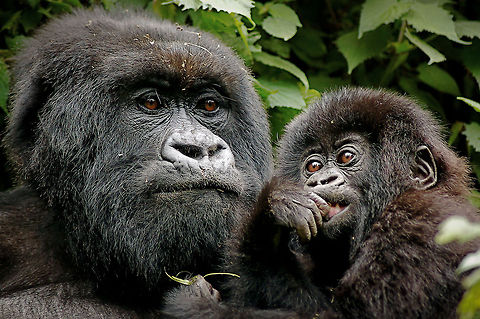
Evolution
Mountain gorillas are descendants of ancestral monkeys and apes found in Africa and Arabia during the start of the oligocene epoch. The fossil record provides evidence of the hominoid primates found in east Africa about 18–22 million years ago. The fossil record of the area where mountain gorillas live is particularly poor and so its evolutionary history is not clear.It was about 9 million years ago that the group of primates that were to evolve into gorillas split from their common ancestor with humans and chimps; this is when the genus "Gorilla" emerged. It is not certain what this early relative of the gorilla was, but it is traced back to the early ape "Proconsul africanus". Mountain gorillas have been isolated from eastern lowland gorillas for about 400,000 years and these two taxa separated from their western counterparts approximately 2 million years ago. There has been considerable and as yet unresolved debate over the classification of mountain gorillas. The genus was first referenced as "Troglodytes" in 1847, but renamed to "Gorilla" in 1852. It was not until 1967 that the taxonomist Colin Groves proposed that all gorillas be regarded as one species with three sub-species "Gorilla gorilla gorilla", "Gorilla gorilla graueri" and "Gorilla gorilla beringei". In 2003 after a review they were divided into two species by The World Conservation Union.
References:
Some text fragments are auto parsed from Wikipedia.